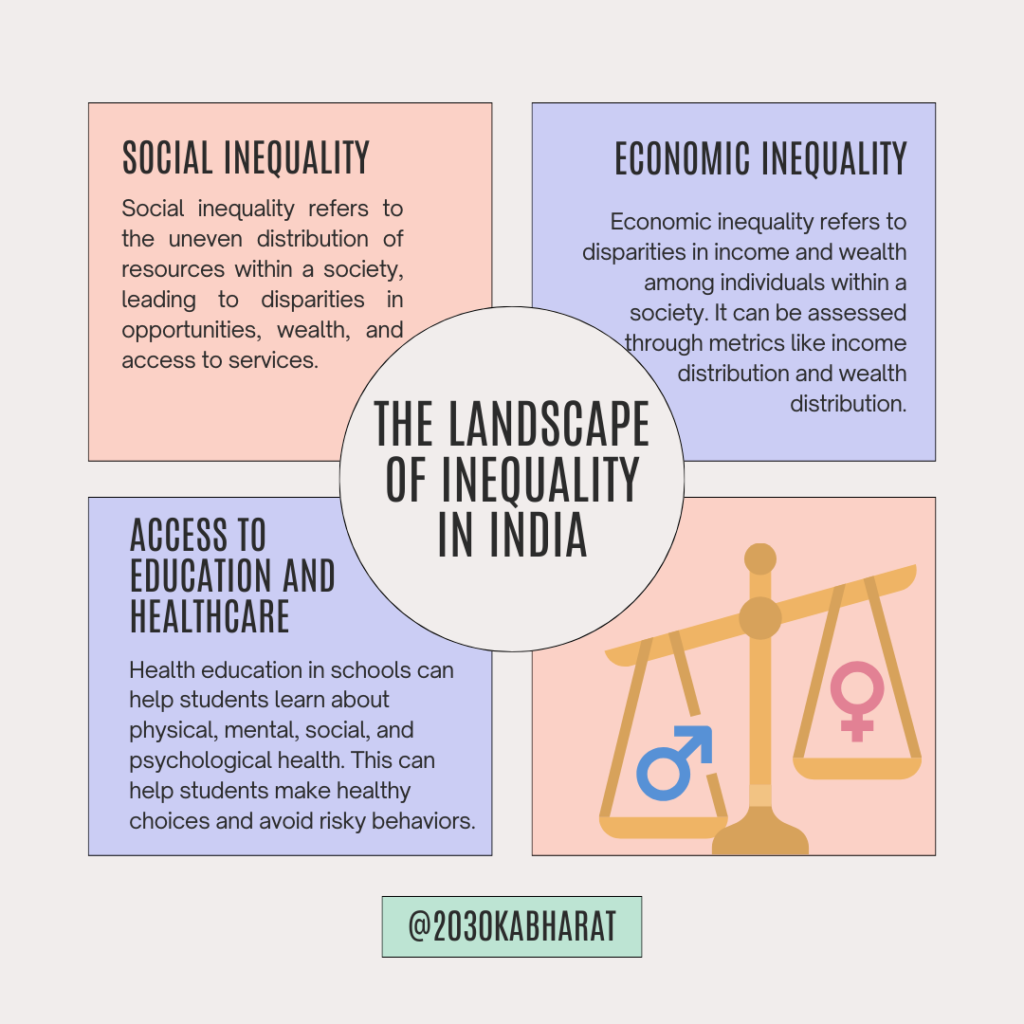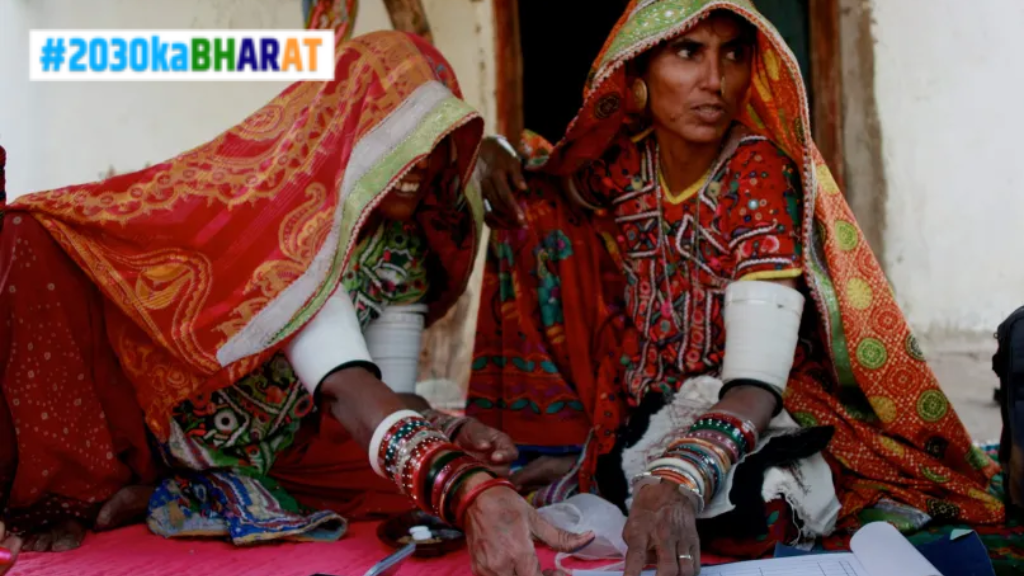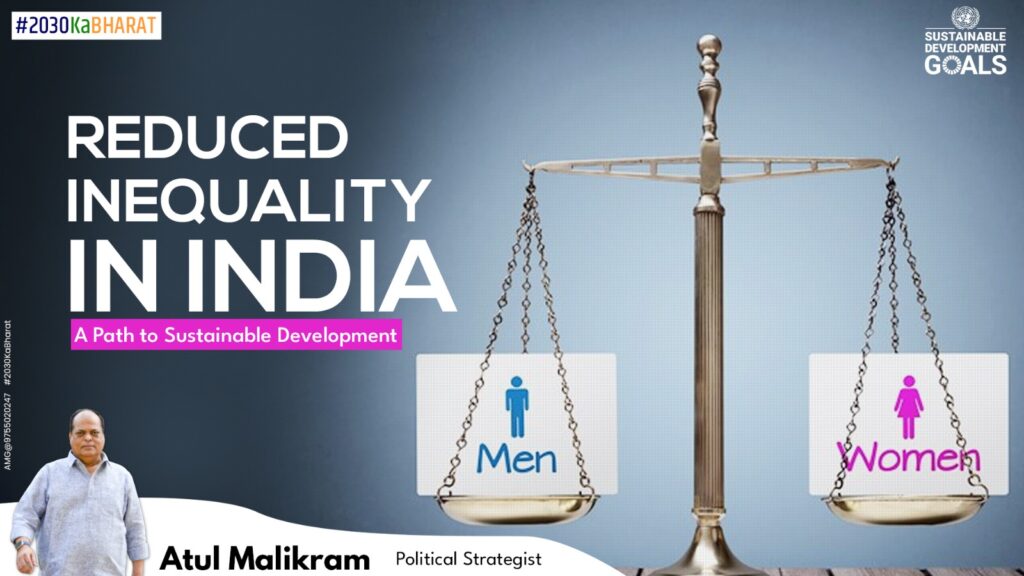I. Reduced Inequality : Introduction
In the rich tapestry of India, the pervasive issue of Reducing Inequality casts a shadow on the nation’s pursuit of sustainable development. Defined by stark contrasts in income, education, and opportunities, addressing this challenge has become a paramount concern for policymakers, activists, and citizens alike. In a country where diversity is celebrated, the challenge lies in creating a society that is equally inclusive. This article delves into the multifaceted nature of inequality in India, exploring its economic, social, and regional dimensions. It scrutinizes the efforts made toward achieving the Sustainable Development Goal (SDG) of “Reduced Inequality.“
II. The Landscape of Inequality in India
A. Economic Inequality
Despite robust economic growth, India grapples with profound economic disparities. According to the World Inequality Database, the top 10% of the population in India owns more than 74% of the national wealth, highlighting a staggering wealth gap. Income inequality is equally alarming, with the richest 1% holding more than 20% of the national income (source: Oxfam India Report). This concentration of wealth in the hands of a few exacerbates the challenges of poverty and social mobility.
B. Social Inequality
- Caste-based Disparities: India’s historical caste system continues to cast a long shadow, affecting social and economic opportunities. Despite constitutional provisions for affirmative action, marginalized communities, especially those belonging to Scheduled Castes and Scheduled Communities, face discrimination in education, employment, and everyday life.
- Gender Inequality: While strides have been made in recent years, gender inequality remains a pervasive issue. The Gender Inequality Index (GII) reveals that India ranks 127 out of 146 countries, reflecting challenges in health, education, and economic empowerment for women.
- Regional Disparities: The uneven distribution of resources and opportunities between urban and rural areas further deepens the social divide. States like Bihar and Jharkhand face higher levels of poverty and limited access to essential services compared to more prosperous regions.
C. Access to Education and Healthcare
- Disparities in Education: The Annual Status of Education Report (ASER) indicates significant disparities in educational outcomes, with children in rural areas and marginalized communities facing challenges in accessing quality education. The digital divide during the COVID-19 pandemic further widened these gaps.
- Healthcare Disparities: Despite progress in healthcare, access to quality services remains unequal. Rural areas often lack adequate healthcare infrastructure, leading to disparities in maternal and child health, disease prevention, and overall well-being.

III. Factors Contributing to Inequality
A. Historical Context
The roots of inequality in India are deeply embedded in its historical legacy. The caste system, prevailing for centuries, created a hierarchical social structure, limiting opportunities for those deemed lower in the social order. Despite constitutional efforts to eradicate untouchability and promote equality, remnants persist, affecting social interactions, education, and employment opportunities.
B. Structural Issues
- Lack of Access to Resources: Land, a critical resource in agrarian economies like India, is often concentrated in the hands of a few, perpetuating economic disparities. Land reform policies have faced challenges in implementation, hindering the distribution of land to marginalized communities.
- Discrimination in the Workplace: Workplace discrimination based on caste, gender, and religion remains a significant hurdle. Affirmative action policies, while commendable in intent, face resistance and implementation challenges, preventing marginalized groups from enjoying equal opportunities in employment.
C. Policy and Governance
- Effectiveness of Social Welfare Programs: While India has implemented various social welfare programs to address inequality, their effectiveness is often marred by bureaucratic inefficiencies, corruption, and inadequate reach. Assessing the impact of these programs is crucial for refining policies and ensuring they benefit the intended beneficiaries.
- Implementation Challenges: The successful execution of policies aimed at reducing inequality faces roadblocks at the grassroots level. Lack of awareness, inadequate infrastructure, and a fragmented approach to implementation hinder the transformative potential of these initiatives.
IV. Progress and Initiatives
A. Government Programs and Policies
- Affirmative Action: Reservation policies in education and employment have been instrumental in providing opportunities to historically marginalized communities. However, there is an ongoing debate about the efficacy and potential alternatives to ensure fair representation without perpetuating stereotypes.
- Poverty Alleviation Programs: Schemes like the Mahatma Gandhi National Rural Employment Guarantee Act (MGNREGA) have contributed to reducing poverty and improving livelihoods in rural areas. However, challenges in timely payment, bureaucratic hurdles, and limited scope need to be addressed for sustained impact.
B. Role of Civil Society and NGOs
- Grassroots Initiatives: Non-governmental organizations and grassroots initiatives play a pivotal role in addressing inequality at the community level. Initiatives focused on education, healthcare, and skill development empower individuals and communities, fostering sustainable change.
- Advocacy for Social Justice: Civil society organizations actively engage in advocacy and awareness campaigns to address systemic issues contributing to inequality. Their role in holding authorities accountable and amplifying the voices of marginalized communities is crucial for driving policy changes.
V. Challenges and Roadblocks
A. Resistance to Change
- Societal Attitudes: Despite concerted efforts, deeply ingrained societal norms and prejudices continue to fuel resistance against initiatives aimed at reducing inequality. Attitudinal shifts are imperative for breaking down barriers and fostering an inclusive society that values diversity.
- Political Challenges: Policymaking often encounters challenges due to political considerations. Striking a balance between the needs of different segments of the population and garnering political support for inclusive policies remains a delicate task.
B. Lack of Comprehensive Data
- Measurement Issues: Accurately gauging the extent of inequality faces hindrances due to gaps in data collection and reporting. Standardized metrics and improved data collection methodologies are essential for informed decision-making and policy evaluation.
- Data Collection Challenges: In remote and marginalized areas, limited infrastructure and resources impede data collection efforts. Innovative approaches, such as leveraging technology for data gathering, can bridge these gaps and provide a more accurate picture of inequality across regions.
VI. Case Studies Of Reduce Inequality
A. Successful Models of Reducing Inequality
1. Kerala’s Development Model
Kerala, often hailed for its unique development trajectory, has stood out as a beacon of success in reducing inequality. The state’s journey began in the mid-20th century, marked by visionary leadership and a commitment to social justice. Land reforms initiated in the 1950s aimed to address the historical concentration of land among a few elite families, thereby empowering marginalized communities. The focus on education and healthcare, driven by the ‘Kerala Model,’ further set the stage for inclusive development.
Achievements:
- Human Development Indicators: Kerala consistently boasts impressive human development indicators, with high literacy rates, life expectancy, and low infant mortality rates.
- Social Welfare Programs: The state’s commitment to social welfare programs, including the expansion of healthcare facilities and educational institutions, has created a more egalitarian society.
- Empowerment of Marginalized Communities: Through affirmative action policies, Kerala has empowered historically marginalized communities, ensuring their participation in the socio-economic fabric of the state.

2. Self-Help Groups in Rajasthan
Rajasthan, a state with a diverse cultural heritage, faced challenges related to economic disparities and gender inequality. The introduction of self-help groups (SHGs) in the late 20th century aimed to address these issues by promoting economic self-sufficiency among women in rural areas. The initiative gained momentum as a grassroots movement, empowering women and fostering community development.
Achievements:
- Economic Empowerment: SHGs in Rajasthan have been instrumental in providing women with the means to generate income, breaking the cycle of poverty and dependency.
- Social Cohesion: Beyond economic benefits, the SHG model has fostered social cohesion and community development, strengthening the social fabric in rural areas.
- Skill Development: Women involved in SHGs often acquire new skills, enabling them to diversify their economic activities and contribute meaningfully to the household and community.

B. Lessons Learned from Failed Attempts
1. Demonetization Impact
In 2016, the Indian government implemented a bold policy of demonetization, withdrawing high-denomination currency notes to curb black money and corruption. While the intention was to promote financial transparency, the impact on various segments of the population, especially those in the informal sector, raised concerns about its efficacy in addressing inequality.
Lessons Learned:
- Impact on Informal Sector: The policy disproportionately affected the informal sector, where a significant portion of the population depends on cash transactions.
- Income Disparities: The economic shock resulted in hardships for vulnerable populations, highlighting the need for inclusive policymaking that considers the diverse economic landscape of the country.
2. Implementation Challenges of GST
The Goods and Services Tax (GST), introduced in 2017, aimed to simplify the tax structure and create a unified market. However, the complex nature of the reform and challenges in its implementation raised concerns about its impact on small businesses and the informal sector.
Lessons Learned:
- Impact on Small Businesses: Small businesses faced challenges in adapting to the new tax structure, affecting their competitiveness and economic viability.
- Need for Inclusive Policy Design: The experience with GST underscored the importance of designing policies that consider the diverse nature of India’s economy, with a focus on supporting small businesses and informal sectors.
VII. Future Prospects
A. Potential Strategies for Further Reduction
- Education Reforms: Investing in quality education and addressing disparities in access can empower future generations, breaking the cycle of poverty and contributing to a more skilled and competitive workforce.
- Enhanced Social Protection: Strengthening social protection programs, including healthcare and social security, can provide a safety net for vulnerable populations, reducing the impact of economic shocks.
B. Importance of Sustainable Development Goals (SDGs)
Aligning efforts with the broader SDGs is essential for comprehensive and sustainable development. Reduced inequality is not only a goal in itself (SDG 10) but also a catalyst for achieving other goals related to poverty eradication, health, and education.
C. Role of Technology and Innovation
Leveraging technology for inclusive growth and innovation can bridge gaps in access to information, education, and financial services. Digital platforms and innovations in agriculture, healthcare, and education have the potential to uplift marginalized communities.

VIII. Reduce Inequality: Conclusion
In conclusion, the journey towards reduced inequality in India is multifaceted, demanding concerted efforts from government, civil society, and the private sector. Learning from both successes and failures, policymakers can refine strategies to address the structural issues contributing to inequality. As India strives for sustainable development, fostering inclusivity and ensuring that no one is left behind must remain at the forefront of the national agenda. By embracing diversity and implementing targeted policies, India can pave the way for a more equitable and prosperous future for all.
Resources:
Global Gender Gap Report 2023: WEF{LINK}
Global Gender Gap Report 2023 [Latest Report LINK]
Kerala Development Model[LINK]
